
Determine the stopping distances for an automobile going a constant initial speed of 95 km/h and human reaction time of 0.40 s:
- for an acceleration ;
- for .

In order to watch this solution you need to have a subscription.
This is Giancoli Answers with Mr. Dychko. To figure out the total distance traveled, we have to add the distance during the reaction time during which there's no acceleration this is before the driver presses on the brake pedal and then add to that the distance traveled while stopping so d subscript s for stopping so this is when there is deceleration. And the initial speed is 95 kilometers an hour which we convert into meters per second by multiplying by 1 hour for every 3600 seconds and the hours cancel and then multiply by 1000 meters per kilometer, kilometers cancel and this is the same as dividing by 3.6 you get 26.3889 meters per second is the initial velocity and case (a) has acceleration of negative 3 meters per second squared maybe this is on a wet day and part (b) could be on a dry day when there's better traction and more deceleration. So the distance traveled during the reaction time is the initial speed multiplied by the reaction time of 0.4 seconds giving 10.556 meters covered before the brakes are pressed. And then during the stopping, we have a final speed of zero and we subtract v i squared from both sides and then divide both sides by 2a as well and then flip the sides around and we end up with d s is I guess it's not quite the right way to say it, let's go like this and we have distance covered while stopping is the initial velocity square that there's a minus in front of that result divided by 2 times negative 3 meters per second squared giving us 116.06 meters and then add that to the distance covered during the reaction time before the brakes are pressed and that gives us a total of 130 meters with two significant figures. When there's more deceleration, negative 6 meters per second squared on a dry day say the distance covered while stopping is less and then we add that to the same distance covered during the reaction time for a total of 69 meters covered while stopping and you know, in total plus the reaction distance.